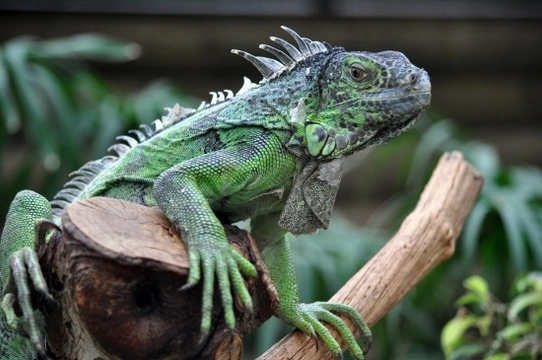
Complete Guide to Types of Iguana and Their Care
Iguanas are fascinating prehistoric reptiles cherished by reptile enthusiasts and dinosaur fans alike. They are not recommended for beginners due to their specialised care needs but provide a unique experience for those familiar with reptile keeping. This guide covers the most common types of iguanas kept as pets or observed in the wild, highlighting their characteristics, natural habitats, and basic care requirements to help you make an informed decision about ownership.
1. Green Iguana
The Green Iguana (Iguana iguana) is the most popular pet species. Despite its name, it shows a stunning range of colours including green, pink, blue, and black. Young green iguanas may be born blue and change colour as they mature. They grow to about 5 feet in length including a long tail and can weigh over 9 kilogrammes, requiring a robust, confident handler. These arboreal reptiles have dorsal spines for protection. When threatened, they use their strong tails, sharp claws, and bite defensively. Green Iguanas are strictly herbivorous; their diet should consist mainly of fresh leafy greens, vegetables, and fruits. Feeding meat or insects can cause kidney damage, so it's best avoided.
2. Red Iguana
Red Iguanas are a colour morph of Green Iguanas selectively bred for their vibrant red and orange hues, though their bellies typically remain green. They share all care needs with the Green Iguana and require a similarly specialised environment. It’s important to source these from reputable breeders to support ethical reptile keeping.
3. Desert Iguana
The Desert Iguana (Dipsosaurus dorsalis) hails from the arid deserts of the southwestern United States and northern Mexico. Smaller than the Green Iguana, they reach about 16 inches, much of it being their distinctive long, banded tail. Their colouring varies from greyish tan to white, and they can change shade during the day to regulate body temperature—darker grey in the cool morning and brighter white at midday to reflect heat. They enjoy burrowing and climbing bushes, so a tank with ample climbing branches and hiding places is essential. Heat lamps should mimic natural desert temperature gradients, providing warm basking spots and cooler shaded areas since these iguanas are ectothermic. Desert Iguanas are shy but very fast and can sprint on their hind legs when threatened.
4. Rhinoceros Iguana
The Rhinoceros Iguana (Cyclura cornuta) is named for the prominent horn-like scales projecting from its snout, resembling a rhinoceros’ horn. Males have larger protrusions and thigh pores emitting pheromones to attract mates. These iguanas prefer rocky, dry terrain and eat a varied herbivorous diet including leaves, fruits, and flowers. When cornered, they can defend themselves fiercely with powerful tail whips and bites. Because of their size and temperament, they should be handled only by experienced keepers. Rhinoceros Iguanas are a protected species, often found in zoos and expert care collections in the UK; owning one requires specialist knowledge and licenses.
5. Angel Island Chuckwalla
The Angel Island Chuckwalla (Sauromalus hispidus) is the most docile among chuckwallas and a surprising choice for a pet given their size. Found naturally on Angel Island, these lizards defend themselves by inflating their lungs and wedging tightly into crevices, aided by their loose, spiny skin. They communicate using head bobs and colour changes. Their skin is covered with fine spines, especially prominent on the head and legs. These adaptations make them quite different from typical iguanas but fascinating companions for experienced reptile keepers.
6. Grand Cayman Iguana
Also known as the Blue Iguana (Cyclura lewisi), this species is endangered and native to the Grand Cayman Islands. Their colour shifts from a rock-grey to a vivid blue when they encounter rivals or mates. Blue Iguanas use their articulated feet to climb trees and strip bark for food. Conservation efforts have revived their numbers from as few as 15 individuals in 2003 to over 750 by 2012 through dedicated reserves. Due to their conservation status, true Blue Iguanas are not sold commercially or exported to collectors or zoos. They are noteworthy not only for their striking colour but also their impressive longevity—up to 69 years documented.
7. Galapagos Land Iguana
Native to the Galapagos Islands and first documented by Charles Darwin, the Galapagos Land Iguana (Conolophus subcristatus) is a uniquely adapted species. They were nearly wiped out in the 1950s due to hunting and invasive predators. Now thriving under an intensive captive breeding programme, they live closely alongside bird populations that clean their ticks and parasites. These iguanas bask extensively to regulate body temperature and retreat into burrows at night due to scarce water sources, feeding primarily on cactus. As a protected species, they’re not available on the pet market, and require conservation-conscious viewing only.
8. Responsible Iguana Ownership
Owning an iguana requires commitment to creating a stable, species-appropriate environment that meets their temperature, diet, and space requirements. It’s vital to source iguanas from reputable breeders who prioritise animal welfare and conservation ethics, avoiding wild-caught or illegally traded animals. Due to their longevity and specialised care, iguanas are not suitable for casual pet owners or children without supervision. Always ensure you understand the legal requirements and veterinary care needed to maintain your iguana’s health and wellbeing.
Understanding this diversity in iguana species helps enthusiasts appreciate their biological uniqueness and choose a species that fits their experience and care capability. This promotes responsible reptile ownership for a rewarding companionship with these prehistoric reptiles.



